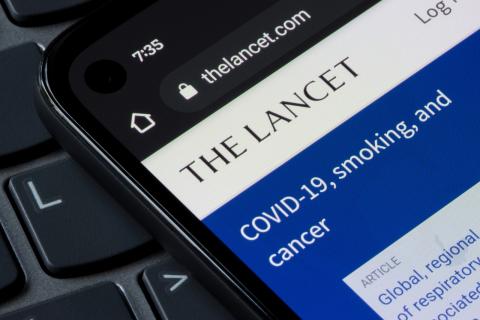New migraine drugs less effective than triptans, says meta-analysis
An international team of researchers has conducted a meta-analysis of 137 clinical trials involving nearly 90,000 people to assess the migraine efficacy of 17 available drugs. Their conclusions are that four drugs in the triptan group are more effective and cheaper than newer drugs such as gepants or lasmiditan, and that the efficacy of the latter is comparable to that of paracetamol and most anti-inflammatory drugs. The results are published in The BMJ.

Pablo Irimia - triptanes migraña EN
Pablo Irimia
Neurologist specialising in the diagnosis and treatment of headaches
The study is of good quality. A considerable amount of data is analysed and the analysis has been conducted by well-known international experts in the diagnosis and treatment of migraine.
This analysis is in line with previously published analyses showing that triptans continue to be more effective than newer marketed drugs. However, some patients do not tolerate or have contraindications to the use of triptans, making alternative treatments such as rimegepant or lasmiditan essential. Furthermore, there is some evidence that frequent use of some of the drugs analysed, such as rimegepant or ubrogepant, is not associated with an increased risk of headache due to overuse of medication. In the case of rimegepant, the drug even has a preventive effect in reducing the number of headache days. This is a great advantage for gepants in patients who require frequent use of analgesics.
[Regarding possible limitations] This is a quality meta-analysis that attempts to compare the efficacy of different drugs. However, there is no direct comparative study of the drugs against each other, which would be the ideal way to know whether triptans are truly superior to the new drugs.
Conflicts of interest: ‘I have received honoraria for participation in training activities from Pfizer, TEVA, Eli, Lilly, Lundbeck and Abbvie’.
David García Azorín - triptanes migraña EN
David García Azorín
Neurologist at the Headache Unit of the Hospital Universitario Clínico de Valladolid
Although meta-analysis is considered to be the highest degree of evidence possible, its interpretation should be cautious, as this is true when the studies included are truly comparable. In the present case, the large number of studies, from different dates and with different ways of assessing the outcome, partly limits its quality, although it is a conscientious and methodologically robust work.
The main novelty is the comparison of ‘new’ treatments for acute migraine attacks with previously existing options, i.e. gepants and lasmiditan versus triptans, anti-inflammatory drugs and paracetamol, respectively.
Considering the individual results of the clinical trials of the ‘new’ treatments, where the published results were already somewhat inferior to those presented when the evidence for the new treatments was generated, this does not come as a great surprise.
In the field of migraine, what patients are looking for is for their attacks to go away quickly, without side effects and without the pain returning within 24 hours. What the results of this work show is that the ‘classic’ drugs seem to have a higher probability of response than the new ones, although the frequency with which patients experience side effects is also higher. In addition, some ‘classical’ drugs may pose a certain risk in certain patients and should be avoided in these patients.
This work reinforces the idea that the treatment of people with migraine and other headaches should be personalised and tailored to the individual patient. Traditional drugs are of great help if they are used appropriately, which is not always the case, and fortunately we now have new tools that can help people who have not benefited sufficiently or who were excluded from these therapies because they have other illnesses or cannot tolerate them adequately.
[Regarding possible limitations] In this work the type of comparison performed is indirect, using network meta-analysis, where the main comparison is based on the difference from the placebo group in each study. It would be expected, therefore, that the placebo response rate would be very similar in all studies, both in measures of efficacy and tolerability, and across studies the outcome was variable.
Conflicts of interest: ‘I have participated as a speaker for AbbVie/Allergan, Eli Lilly, Teva, Lundbeck, Organon and Novartis. I have participated as principal investigator in clinical trials for Pfizer, BioHaven, and Lundbeck. I am editor of The Journal of Headache and Pain, Neurological Sciences and Cephalalgia. I have participated as an expert for the World Health Organization'.
Robert Belvís - triptanes migraña EN
Robert Belvís
Clinical Head of the Headache and Neuralgia Unit at the Neurology Department of the Hospital de la Santa Creu i Sant Pau in Barcelona
As is well known, the optimal way to compare the efficacy of two drugs is called a double-blind randomised clinical trial, also known as head-to-head. I am not aware of any trial of a triptan versus a gepant or lasmiditan.
This article is a meta-analysis comparing placebo trials of triptans in the 1990s versus current trials of the new drugs.
The methodology has changed in these 20 years. In fact, the migraine criteria have changed (twice) and even the IHS [International Headache Society] migraine attack trial methodology guidelines have changed.
No one would think of comparing 20th century penicillin trials with today's amoxicillin trials in a particular infection.
It seems to me that, despite the statistics, it is very risky to conclude so strongly with the assertions made by the authors.
Opinion is one thing, science is another. Without a head-to-head trial of triptan vs. gepant or triptan vs. lasmiditan, we are unlikely to know which is more effective.
On the other hand, triptans are not effective in all patients and their therapeutic persistence at one year is low, so switching between them is common. Therefore, we need new drugs.
Finally, the IPT [Therapeutic Positioning Report] criteria for the National Health System (SNS) funding of lasmiditan position it as a failure, contraindication or adverse effect of triptans. As for the only gepant approved in Spain for migraine attacks, rimegepant, in the end it has not been funded by the SNS.
Therefore, we will continue to offer triptans to our patients as a first option for severe migraine attacks and anti-inflammatory drugs for moderate migraine attacks.
This meta-analysis changes absolutely nothing in Spain.
Conflicts of interest: “Allergan, Abbvie, Novartis, Orgaon, Lilly, Teva, Almirall, Dr Reddy, Abbot, Biogen, Noema, Exeltis, Lundbeck, Pfizer, Boston, Cardiva, Prim, Bial, Biohaven, Chiesi, Merck”.
Patricia Pozo - triptanes migraña EN
Patricia Pozo Rosich
Neurologist, expert in migraine, head of section of the Neurology Service of the Vall d'Hebron Hospital in Barcelona
Meta-analyses are not head-to-head studies, but we understand that it is the least ‘bad’ way to compare.
Not everything is based on efficacy of a treatment. Triptans are used less than they should/could be, but they are not effective in everyone:
- They are not effective in everyone; and to be effective they need to be administered within a therapeutic window that requires patient education.
- If taken in excess they generate a worsening of migraine (excess being >10 days per month, generating a headache due to overuse of analgesic medication).
- They are not always well tolerated.
- Lasmiditan is perhaps comparatively less effective, is also not always well tolerated and may, like triptans, facilitate the development of analgesic overuse, but it is cardiosafe.
- The gepants are perhaps less effective, but they offer new differences in that there is no evidence that they generate headache secondary to drug overuse, they have no therapeutic window and, in fact, their continued use helps to modulate the disease and they can also be used (for example, rimegepant) as a preventive treatment.
- And like triptans, gepants are also not effective for everyone.
What I mean by this is that migraine treatment must be prioritised. On a scientific level, now with more drugs available for the treatment of migraine attacks, we will have to develop ways to try to be able to offer the right treatment for each person at the right time, in other words, to develop precision medicine strategies.
Finally, as a comment, in Spain lasmiditan is only funded in some very specific situations, and gepants are not funded as a treatment for migraine attacks.
Karlsson et al.
- Research article
- Peer reviewed
- Systematic review
- Meta-analysis



